Optical Fiber Probe Microcantilever Sensor Based on Fabry–Perot Interferometer
Abstract
1. Introduction
2. Fundamental of Optical Fiber Microcantilever Sensor
3. Fiber-Top Microcantilever Sensor
3.1. Focused Ion Beam Milling
3.2. Chemical Etching
3.3. Picosecond-Laser Ablation
3.4. Photolithography
3.5. Two-Photon Polymerization
4. Ferrule-Top Microcantilever Sensor
4.1. Glass Ferrule-Top Microcantilever Sensor
4.2. Ceramic Ferrule-Top Microcantilever Sensor
5. Other Microcantilever Sensors
6. Comparison of Optical Fiber Probe Microcantilever Sensor
7. Conclusions and Outlook
Author Contributions
Funding
Institutional Review Board Statement
Informed Consent Statement
Data Availability Statement
Conflicts of Interest
References
- Roriz, P.; Silva, S.; Frazao, O.; Novais, S. Optical Fiber Temperature Sensors and Their Biomedical Applications. Sensors 2020, 20, 2113. [Google Scholar] [CrossRef]
- Dai, J.X.; Zhu, L.; Wang, G.P.; Xiang, F.; Qin, Y.H.; Wang, M.; Yang, M.H. Optical Fiber Grating Hydrogen Sensors: A Review. Sensors 2017, 17, 577. [Google Scholar] [CrossRef]
- Zhao, Y.; Li, X.G.; Zhou, X.; Zhang, Y.N. Review on the graphene based optical fiber chemical and biological sensors. Sens. Actuator B Chem. 2016, 231, 324–340. [Google Scholar] [CrossRef]
- Poeggel, S.; Tosi, D.; Duraibabu, D.; Leen, G.; McGrath, D.; Lewis, E. Optical Fibre Pressure Sensors in Medical Applications. Sensors 2015, 15, 17115–17148. [Google Scholar] [CrossRef]
- Di, H.T.; Xin, Y.; Jian, J.Q. Review of optical fiber sensors for deformation measurement. Optik 2018, 168, 703–713. [Google Scholar] [CrossRef]
- Wang, Q.; Liu, Y. Review of optical fiber bending/curvature sensor. Measurement 2018, 130, 161–176. [Google Scholar] [CrossRef]
- Ding, Z.Y.; Wang, C.H.; Liu, K.; Jiang, J.F.; Yang, D.; Pan, G.Y.; Pu, Z.L.; Liu, T.G. Distributed Optical Fiber Sensors Based on Optical Frequency Domain Reflectometry: A review. Sensors 2018, 18, 1072. [Google Scholar] [CrossRef] [PubMed]
- Korposh, S.; James, S.W.; Lee, S.W.; Tatam, R.P. Tapered Optical Fibre Sensors: Current Trends and Future Perspectives. Sensors 2019, 19, 2294. [Google Scholar] [CrossRef] [PubMed]
- Pospisilova, M.; Kuncova, G.; Trogl, J. Fiber-Optic Chemical Sensors and Fiber-Optic Bio-Sensors. Sensors 2015, 15, 25208–25259. [Google Scholar] [CrossRef] [PubMed]
- Gomez, J.; Casas, J.R.; Villalba, S. Structural Health Monitoring with Distributed Optical Fiber Sensors of tunnel lining affected by nearby construction activity. Autom. Constr. 2020, 117, 103261. [Google Scholar] [CrossRef]
- Chan, H.M.; Parker, A.R.; Piazza, A.; Richards, W.L. Fiber-Optic Sensing System: Overview, Development and Deployment in Flight at NASA. In Proceedings of the IEEE Avionics and Vehicle Fiber-Optics and Photonics Conference, Santa Barbara, CA, USA, 10–12 November 2015; pp. 71–73. [Google Scholar]
- Correia, R.; James, S.; Lee, S.W.; Morgan, S.P.; Korposh, S. Biomedical application of optical fibre sensors. J. Opt. 2018, 20, 073003. [Google Scholar] [CrossRef]
- Leal, A.G.; Marques, C.; Frizera, A.; Pontes, M.J. Multi-interface level in oil tanks and applications of optical fiber sensors. Opt. Fiber Technol. 2018, 40, 82–92. [Google Scholar] [CrossRef]
- Bohnert, K.; Gabus, P.; Kostovic, J.; Brandle, H. Optical fiber sensors for the electric power industry. Opt. Lasers Eng. 2005, 43, 511–526. [Google Scholar] [CrossRef]
- Min, R.; Liu, Z.Y.; Luis, P.; Yang, C.K.; Sui, Q.; Carlos, M. Optical fiber sensing for marine environment and marine structural health monitoring: A review. Opt. Laser Technol. 2021, 140, 107082. [Google Scholar] [CrossRef]
- Zhou, N.; Jia, P.G.; Liu, J.; Ren, Q.Y.; An, G.W.; Liang, T.; Xiong, J.J. MEMS-Based Reflective Intensity-Modulated Fiber-Optic Sensor for Pressure Measurements. Sensors 2020, 20, 2233. [Google Scholar] [CrossRef] [PubMed]
- Polygerinos, P.; Seneviratne, L.D.; Althoefer, K. Modeling of Light Intensity-Modulated Fiber-Optic Displacement Sensors. IEEE Trans. Instrum. Meas. 2011, 60, 1408–1415. [Google Scholar] [CrossRef]
- Raji, Y.M.; Lin, H.S.; Ibrahim, S.A.; Mokhtar, M.R.; Yusoff, Z. Intensity-modulated abrupt tapered Fiber Mach-Zehnder Interferometer for the simultaneous sensing of temperature and curvature. Opt. Laser Technol. 2016, 86, 8–13. [Google Scholar] [CrossRef]
- Cao, J.N.; Wang, W.X.; Zhang, Y.B.; Fu, J.Z. Design of a practical intensity modulated dynamic optical fiber accelerometer. In Proceedings of the Conference on Advanced Sensor Systems and Applications II, Beijing, China, 8–12 November 2004; pp. 548–552. [Google Scholar]
- Leal, A.G.; Diaz, C.R.; Marques, C.; Pontes, M.J.; Frizera, A. Multiplexing technique for quasi-distributed sensors arrays in polymer optical fiber intensity variation-based sensors. Opt. Laser Technol. 2019, 111, 81–88. [Google Scholar] [CrossRef]
- Broadway, C.; Kinet, D.; Theodosiou, A.; Kalli, K.; Gusarov, A.; Caucheteur, C.; Megret, P. CYTOP Fibre Bragg Grating Sensors for Harsh Radiation Environments. Sensors 2019, 19, 2853. [Google Scholar] [CrossRef] [PubMed]
- Rego, G.M.; Salgado, H.M.; Santos, J.L. Interrogation of a fiber Bragg grating using a mechanically induced long-period fiber grating. IEEE Sens. J. 2006, 6, 1592–1595. [Google Scholar] [CrossRef]
- Wei, W.; Nong, J.P.; Tang, L.L.; Wang, N.; Chuang, C.J.; Huang, Y. Graphene-MoS2 Hybrid Structure Enhanced Fiber Optic Surface Plasmon Resonance Sensor. Plasmonics 2017, 12, 1205–1212. [Google Scholar] [CrossRef]
- Socorro, A.B.; Corres, J.M.; Del Villar, I.; Arregui, F.J.; Matias, I.R. Fiber-optic biosensor based on lossy mode resonances. Sens. Actuator B-Chem. 2012, 174, 263–269. [Google Scholar] [CrossRef]
- Lee, B.H.; Kim, Y.H.; Park, K.S.; Eom, J.B.; Kim, M.J.; Rho, B.S.; Choi, H.Y. Interferometric Fiber Optic Sensors. Sensors 2012, 12, 2467–2486. [Google Scholar] [CrossRef] [PubMed]
- Wang, B.T.; Niu, Y.X.; Zheng, S.W.; Yin, Y.H.; Ding, M. A High Temperature Sensor Based on Sapphire Fiber Fabry-Perot Interferometer. IEEE Photonics Technol. Lett 2020, 32, 89–92. [Google Scholar] [CrossRef]
- Wang, R.H.; Zhang, J.; Weng, Y.Y.; Rong, Q.Z.; Ma, Y.; Feng, Z.Y.; Hu, M.L.; Qiao, X.G. Highly Sensitive Curvature Sensor Using an In-Fiber Mach-Zehnder Interferometer. IEEE Sens. J. 2013, 13, 1766–1770. [Google Scholar] [CrossRef]
- Shi, J.; Wang, Y.Y.; Xu, D.G.; Zhang, H.W.; Su, G.H.; Duan, L.C.; Yan, C.; Yan, D.X.; Fu, S.J.; Yao, J.Q. Temperature Sensor Based on Fiber Ring Laser With Sagnac Loop. IEEE Photonics Technol. Lett. 2016, 28, 794–797. [Google Scholar] [CrossRef]
- Zhang, Y.A.; Huang, J.; Lan, X.W.; Yuan, L.; Xiao, H. Simultaneous measurement of temperature and pressure with cascaded extrinsic Fabry-Perot interferometer and intrinsic Fabry-Perot interferometer sensors. Opt. Eng. 2014, 53, 067101. [Google Scholar] [CrossRef]
- Yu, H.H.; Luo, Z.Z.; Zheng, Y.; Ma, J.; Li, Z.Y.; Jiang, X. Temperature-Insensitive Vibration Sensor With Kagome Hollow-Core Fiber Based Fabry-Perot Interferometer. J. Lightwave Technol. 2019, 37, 2261–2269. [Google Scholar] [CrossRef]
- Monteiro, C.S.; Ferreira, M.S.; Silva, S.O.; Kobelke, J.; Schuster, K.; Bierlich, J.; Frazao, O. Fiber Fabry-Perot Interferometer for Curvature Sensing. Photonic Sens. 2016, 6, 339–344. [Google Scholar] [CrossRef]
- Chen, W.M.; Lei, X.H.; Zhang, W.; Liu, X.M.; Liao, C.R. Recent Progress of Optical Fiber Fabry-Perot Sensors. Acta Opt. Sin. 2018, 38, 0328010. [Google Scholar] [CrossRef]
- Ma, Z.B.; Cheng, S.L.; Kou, W.Y.; Chen, H.B.; Wang, W.; Zhang, X.X.; Guo, T.X. Sensitivity-Enhanced Extrinsic Fabry-Perot Interferometric Fiber-Optic Microcavity Strain Sensor. Sensors 2019, 19, 4097. [Google Scholar] [CrossRef]
- Wang, R.K.; Xie, X.J.; Xu, X.G.; Chen, X.F.; Xiao, L.F. Comparison of Measurements with Finite-Element Analysis of Silicon-Diaphragm-Based Fiber-Optic Fabry-Perot Temperature Sensors. Sensors 2019, 19, 4780. [Google Scholar] [CrossRef] [PubMed]
- Ruggeri, F.S.; Sneideris, T.; Vendruscolo, M.; Knowles, T. Atomic force microscopy for single molecule characterisation of protein aggregation. Arch. Biochem. Biophys. 2019, 664, 134–148. [Google Scholar] [CrossRef] [PubMed]
- Pooser, R.C.; Savino, N.; Batson, E.; Beckey, J.L.; Garcia, J.; Lawrie, B.J. Truncated Nonlinear Interferometry for Quantum-Enhanced Atomic Force Microscopy. Phys. Rev. Lett. 2020, 124, 230504. [Google Scholar] [CrossRef] [PubMed]
- Allendorf, M.D.; Houk, R.; Andruszkiewicz, L.; Talin, A.A.; Pikarsky, J.; Choudhury, A.; Gall, K.A.; Hesketh, P.J. Stress-induced Chemical Detection Using Flexible Metal-Organic Frameworks. J. Am. Chem. Soc. 2008, 130, 14404–14405. [Google Scholar] [CrossRef] [PubMed]
- Pooser, R.C.; Lawrie, B. Ultrasensitive measurement of microcantilever displacement below the shot-noise limit. Optica 2015, 2, 393–399. [Google Scholar] [CrossRef]
- Cakmak, O.; Ermek, E.; Kilinc, N.; Yaralioglu, G.G.; Urey, H. Precision density and viscosity measurement using two cantilevers with different widths. Sens. Actuator A Phys. 2015, 232, 141–147. [Google Scholar] [CrossRef]
- Xu, J.S.; Bertke, M.; Li, X.J.; Mu, H.B.; Zhou, H.; Yu, F.; Hamdana, G.; Schmidt, A.; Bremers, H.; Peiner, E. Fabrication of ZnO nanorods and Chitosan@ZnO nanorods on MEMS piezoresistive self-actuating silicon microcantilever for humidity sensing. Sens. Actuator B-Chem. 2018, 273, 276–287. [Google Scholar] [CrossRef]
- Iannuzzi, D.; Deladi, S.; Gadgil, V.J.; Sanders, R.; Schreuders, H.; Elwenspoek, M.C. Monolithic fiber-top sensor for critical environments and standard applications. Appl. Phys. Lett. 2006, 88, 053501. [Google Scholar] [CrossRef]
- Stoney, G.G. The tension of metallic films deposited by elecrtolysis. Proc. Roy. Soc. A 1909, 82, 172–175. [Google Scholar]
- Li, J.; Albri, F.; Maier, R.; Shu, W.M.; Sun, J.N.; Hand, D.P.; MacPherson, W.N. A Micro-Machined Optical Fiber Cantilever as a Miniaturized pH Sensor. IEEE Sens. J. 2015, 15, 7221–7228. [Google Scholar]
- Deladi, S.; Iannuzzi, D.; Gadgil, V.J.; Schreuders, H.; Elwenspoek, M.C. Carving fiber-top optomechanical transducers from an optical fiber. J. Micromech. Microeng. 2006, 16, 886–889. [Google Scholar] [CrossRef][Green Version]
- Iannuzzi, D.; Deladi, S.; Berenschot, J.W.; de Man, S.; Heeck, K.; Elwenspoek, M.C. Fiber-top atomic force microscope. Rev. Sci. Instrum. 2006, 77, 106105. [Google Scholar] [CrossRef]
- Tiribilli, B.; Margheri, G.; Baschieri, P.; Menozzi, C.; Chavan, D.; Iannuzzi, D. Fibre-top atomic force microscope probe with optical near-field detection capabilities. J. Microsc. 2011, 242, 10–14. [Google Scholar] [CrossRef]
- Kou, J.L.; Feng, J.; Wang, Q.J.; Xu, F.; Lu, Y.Q. Microfiber-probe-based ultrasmall interferometric sensor. Opt. Lett. 2010, 35, 2308–2310. [Google Scholar] [CrossRef]
- Andre, R.M.; Warren-Smith, S.C.; Becker, M.; Dellith, J.; Rothhardt, M.; Zibaii, M.I.; Latifi, H.; Marques, M.B.; Bartelt, H.; Frazao, O. Simultaneous measurement of temperature and refractive index using focused ion beam milled Fabry-Perot cavities in optical fiber micro-tips. Opt. Express 2016, 24, 14053–14065. [Google Scholar] [CrossRef] [PubMed]
- Cui, M.X.; Van Hoorn, C.H.; Iannuzzi, D. Miniaturized fibre-top cantilevers on etched fibres. J. Microsc. 2016, 264, 370–374. [Google Scholar] [CrossRef] [PubMed][Green Version]
- Iannuzzi, D.; Deladi, S.; Slaman, M.; Rector, J.H.; Schreuders, H.; Elwenspoek, M.C. A fiber-top cantilever for hydrogen detection. Sens. Actuator B-Chem. 2007, 121, 706–708. [Google Scholar] [CrossRef]
- Bellouard, Y.; Said, A.; Dugan, M.; Bado, P. Fabrication of high-aspect ratio, micro-fluidic channels and tunnels using femtosecond laser pulses and chemical etching. Opt. Express 2004, 12, 2120–2129. [Google Scholar] [CrossRef] [PubMed]
- Juodkazis, S.; Nishi, Y.; Misawa, H. Femtosecond laser-assisted formation of channels in sapphire using KOH solution. Phys. Status Solidi-Rapid Res. Lett. 2008, 2, 275–277. [Google Scholar] [CrossRef]
- Sugioka, K.; Cheng, Y. Femtosecond laser processing for optofluidic fabrication. Lab Chip 2012, 12, 3576–3589. [Google Scholar] [CrossRef] [PubMed]
- Said, A.A.; Dugan, M.; de Man, S.; Iannuzzi, D. Carving fiber-top cantilevers with femtosecond laser micromachining. J. Micromech. Microeng. 2008, 18, 035005. [Google Scholar] [CrossRef]
- Albri, F.; Li, J.; Maier, R.; MacPherson, W.N.; Hand, D.P. Laser machining of sensing components on the end of optical fibres. J. Micromech. Microeng. 2013, 23, 045021. [Google Scholar] [CrossRef]
- Li, J.; Albri, F.; Sun, J.N.; Miliar, M.M.; Maier, R.; Hand, D.P.; MacPherson, W.N. Fabricating optical fibre-top cantilevers for temperature sensing. Meas. Sci. Technol. 2014, 25, 035206. [Google Scholar] [CrossRef]
- Gavan, K.B.; Rector, J.H.; Heeck, K.; Chavan, D.; Gruca, G.; Oosterkamp, T.H.; Iannuzzi, D. Top-down approach to fiber-top cantilevers. Opt. Lett. 2011, 36, 2898–2900. [Google Scholar] [CrossRef]
- Rector, J.H.; Slaman, M.; Verdoold, R.; Iannuzzi, D.; Beekmans, S.V. Optimization of the batch production of silicon fiber-top MEMS devices. J. Micromech. Microeng. 2017, 27, 115005. [Google Scholar] [CrossRef]
- Xiong, C.; Zhou, J.T.; Liao, C.R.; Zhu, M.; Wang, Y.; Liu, S.; Li, C.; Zhang, Y.F.; Zhao, Y.Y.; Gan, Z.S.; et al. Fiber-Tip Polymer Microcantilever for Fast and Highly Sensitive Hydrogen Measurement. ACS Appl. Mater. Interfaces 2020, 12, 33163–33172. [Google Scholar] [CrossRef] [PubMed]
- Malinauskas, M.; Gilbergs, H.; Zukauskas, A.; Purlys, V.; Paipulas, D.; Gadonas, R. A femtosecond laser-induced two-photon photopolymerization technique for structuring microlenses. J. Opt. 2010, 12, 035204. [Google Scholar] [CrossRef]
- Trautmann, A.; Ruth, M.; Lemke, H.D.; Walther, T.; Hellmann, R. Two-photon polymerization based large scaffolds for adhesion and proliferation studies of human primary fibroblasts. Opt. Laser Technol. 2018, 106, 474–480. [Google Scholar] [CrossRef]
- Raimondi, M.T.; Eaton, S.M.; Nava, M.M.; Lagana, M.; Cerullo, G.; Osellame, R. Two-photon laser polymerization: From fundamentals to biomedical application in tissue engineering and regenerative medicine. J. Appl. Biomater. Funct. Mater. 2012, 10, 56–66. [Google Scholar] [CrossRef]
- Zhang, D.Y.; Men, L.Q.; Chen, Q.Y. Femtosecond Laser Microfabricated Optofluidic Mach-Zehnder Interferometer for Refractive Index Sensing. IEEE J. Quantum Electron. 2018, 54, 7600107. [Google Scholar] [CrossRef]
- Changrui, L.; Cong, X.; Jinlai, Z.; Mengqiang, Z.; Yuanyuan, Z.; Bozhe, L.; Peng, J.; Zhihao, C.; Zongsong, G.; Ying, W.; et al. Design and realization of 3D printed fiber-tip microcantilever probes applied to hydrogen sensing. Light Adv. Manuf. 2022, 3, 1–11. [Google Scholar]
- Gruca, G.; de Man, S.; Slaman, M.; Rector, J.H.; Iannuzzi, D. Ferrule-top micromachined devices: Design, fabrication, performance. Meas. Sci. Technol. 2010, 21, 094033. [Google Scholar] [CrossRef]
- Cipullo, A.; Gruca, G.; Heeck, K.; De Filippis, F.; Iannuzzi, D.; Zeni, L. Ferrule-top cantilever optical fiber sensor for velocity measurements of low speed air flows. In Proceedings of the 21st International Conference on Optical Fiber Sensors, Ottawa, ON, Canada, 17 May 2011; p. 775340. [Google Scholar]
- Cipullo, A.; Gruca, G.; Heeck, K.; De Filippis, F.; Iannuzzi, D.; Minardo, A.; Zeni, L. Numerical study of a ferrule-top cantilever optical fiber sensor for wind-tunnel applications and comparison with experimental results. Sens. Actuator A Phys. 2012, 178, 17–25. [Google Scholar] [CrossRef]
- Zuurbier, p.; de Man, S.; Gruca, G.; Heeck, K.; Iannuzzi, D. Measurement of the Casimir force with a ferrule-top sensor. New J. Phys. 2011, 13, 023027. [Google Scholar] [CrossRef]
- Chavan, D.; Gruca, G.; de Man, S.; Slaman, M.; Rector, J.H.; Heeck, K.; Iannuzzi, D. Ferrule-top atomic force microscope. Rev. Sci. Instrum. 2010, 81, 123702. [Google Scholar] [CrossRef]
- Chavan, D.; Andres, D.; Iannuzzi, D. Ferrule-top atomic force microscope. II. Imaging in tapping mode and at low temperature. Rev. Sci. Instrum. 2011, 82, 046107. [Google Scholar] [CrossRef]
- Schenato, L.; Palmieri, L.; Gruca, G.; Iannuzzi, D.; Marcato, G.; Pasuto, A.; Galtarossa, A. Fiber optic sensors for precursory acoustic signals detection in rockfall events. J. Eur. Opt. Soc.-Rapid Publ. 2012, 7, 12048. [Google Scholar] [CrossRef]
- Chavan, D.; Gruca, G.; van de Watering, T.; Heeck, K.; Rector, J.; Slaman, M.; Andres, D.; Tiribilli, B.; Margheri, G.; Iannuzzi, D. Fiber-top and ferrule-top cantilevers for atomic force microscopy and scanning near field optical microscopy. In Proceedings of the Conference on Optical Micro- and Nanometrology IV, Brussels, Belgium, 16–18 April 2012. [Google Scholar]
- Chavan, D.; Mo, J.H.; de Groot, M.; Meijering, A.; de Boer, J.F.; Iannuzzi, D. Collecting optical coherence elastography depth profiles with a micromachined cantilever probe. Opt. Lett. 2013, 38, 1476–1478. [Google Scholar] [CrossRef]
- Gruca, G.; Chavan, D.; Rector, J.; Heeck, K.; Iannuzzi, D. Demonstration of an optically actuated ferrule-top device for pressure and humidity sensing. Sens. Actuator A Phys. 2013, 190, 77–83. [Google Scholar] [CrossRef]
- Pisco, M.; Bruno, F.; Galluzzo, D.; Nardone, L.; Gruca, G.; Rijnveld, N.; Bianco, F.; Cutolo, A.; Cusano, A. Opto-mechanical lab-on-fibre seismic sensors detected the Norcia earthquake. Sci. Rep. 2018, 8, 6680. [Google Scholar] [CrossRef] [PubMed]
- Bruno, F.A.; Pisco, M.; Gruca, G.; Rijnveld, N.; Cusano, A. Opto-Mechanical Lab-on-Fiber Accelerometers. J. Lightwave Technol. 2020, 38, 1998–2009. [Google Scholar] [CrossRef]
- Li, J.; Zhou, Y.X.; Guo, Y.X.; Wang, G.Y.; Maier, R.; Hand, D.P.; MacPherson, W.N. Label-free ferrule-top optical fiber micro-cantilever biosensor. Sens. Actuator A Phys. 2018, 280, 505–512. [Google Scholar] [CrossRef]
- Chen, K.; Yu, Z.H.; Yu, Q.X.; Guo, M.; Zhao, Z.H.; Qu, C.; Gong, Z.F.; Yang, Y. Fast demodulated white-light interferometry-based fiber-optic Fabry-Perot cantilever microphone. Opt. Lett. 2018, 43, 3417–3420. [Google Scholar] [CrossRef]
- Chen, K.; Yu, Q.X.; Gong, Z.F.; Guo, M.; Qu, C. Ultra-high sensitive fiber-optic Fabry-Perot cantilever enhanced resonant photoacoustic spectroscopy. Sens. Actuator B Chem. 2018, 268, 205–209. [Google Scholar] [CrossRef]
- Chen, K.; Yu, Z.H.; Gong, Z.F.; Yu, Q.X. Lock-in white-light-interferometry-based all-optical photoacoustic spectrometer. Opt. Lett. 2018, 43, 5038–5041. [Google Scholar] [CrossRef]
- Guo, M.; Chen, K.; Gong, Z.F.; Yu, Q.X. Trace Ammonia Detection Based on Near-Infrared Fiber-Optic Cantilever-Enhanced Photoacoustic Spectroscopy. Photonic Sens. 2019, 9, 293–301. [Google Scholar] [CrossRef]
- Gong, Z.F.; Wu, G.J.; Jiang, X.; Li, H.E.; Gao, T.L.; Guo, M.; Ma, F.X.; Chen, K.; Mei, L.; Peng, W.; et al. All-optical high-sensitivity resonant photoacoustic sensor for remote CH4 gas detection. Opt. Express. 2021, 29, 13600–13609. [Google Scholar] [CrossRef]
- Chen, K.; Yang, B.L.; Deng, H.; Guo, M.; Zhang, B.; Yang, Y.; Liu, S.; Zhao, Y.M.; Peng, W.; Yu, Q.X. Simultaneous measurement of acoustic pressure and temperature using a Fabry-Perot interferometric fiber-optic cantilever sensor. Opt. Express 2020, 28, 15050–15061. [Google Scholar] [CrossRef]
- Chen, K.; Guo, M.; Yang, B.L.; Jin, F.; Wang, G.Z.; Ma, F.X.; Li, C.Y.; Zhang, B.; Deng, H.; Gong, Z.F. Highly Sensitive Optical Fiber Photoacoustic Sensor for In Situ Detection of Dissolved Gas in Oil. IEEE Trans. Instrum. Meas. 2021, 70, 7005808. [Google Scholar] [CrossRef]
- Xin, F.X.; Yang, D.W.; Li, C.; Yan, W.; Wang, Y. Detection of CO2 concentration using a fiber-optic cantilever acoustic sensor in 2. 0-μm band. In proceedings of the International Conference on Optoelectronic and Microelectronic Technology and Application, Nanjing, China, 20–22 October 2020. [Google Scholar]
- Lauwers, T.; Gliere, A.; Basrour, S. An all-Optical Photoacoustic Sensor for the Detection of Trace Gas. Sensors 2020, 20, 3967. [Google Scholar] [CrossRef] [PubMed]
- Gong, Z.F.; Li, H.E.; Jiang, X.; Wu, G.J.; Gao, T.L.; Guo, M.; Ma, F.X.; Chen, K.; Mei, L.; Peng, W.; et al. A Miniature Fiber-Optic Silicon Cantilever-Based Acoustic Sensor Using Ultra-High Speed Spectrum Demodulation. IEEE Sens. J. 2021, 21, 20086–20091. [Google Scholar] [CrossRef]
- Guo, M.; Chen, K.; Yang, B.L.; Li, C.Y.; Zhang, B.; Yang, Y.; Wang, Y.; Li, C.X.; Gong, Z.F.; Ma, F.X.; et al. Ultrahigh Sensitivity Fiber-Optic Fabry-Perot Interferometric Acoustic Sensor Based on Silicon Cantilever. IEEE Trans. Instrum. Meas. 2021, 70, 9511908. [Google Scholar] [CrossRef]
- Guo, M.; Chen, K.; Li, C.X.; Xu, L.; Zhang, G.Y.; Wang, N.; Li, C.Y.; Ma, F.X.; Gong, Z.F.; Yu, Q.X. High-Sensitivity Silicon Cantilever-Enhanced Photoacoustic Spectroscopy Analyzer with Low Gas Consumption. Anal. Chem 2022, 94, 1151–1157. [Google Scholar] [CrossRef]
- Sun, J.; Li, J.; Maier, R.; Hand, D.P.; MacPherson, W.N.; Miller, M.K.; Ritchie, J.M.; Luo, X. Fabrication of a side aligned optical fibre interferometer by focused ion beam machining. J. Micromech. Microeng. 2013, 23, 105005. [Google Scholar] [CrossRef]
- Li, J.; Wang, G.Y.; Sun, J.N.; Maier, R.; Macpherson, W.N.; Hand, D.P.; Dong, F.Z. Micro-Machined Optical Fiber Side-Cantilevers for Acceleration Measurement. IEEE Photonics Technol. Lett. 2017, 29, 1836–1839. [Google Scholar] [CrossRef]
- Liu, J.; Yuan, L.; Huang, J.; Xiao, H. A cantilever based optical fiber acoustic sensor fabricated by femtosecond laser micromachining. In Proceedings of the Conference on Laser 3D Manufacturing III, San Francisco, CA, USA, 15–18 February 2016. [Google Scholar]
- Liu, J.; Yuan, L.; Lei, J.C.; Zhu, W.E.; Cheng, B.K.; Zhang, Q.; Song, Y.; Chen, C.; Xiao, H. Micro-cantilever-based fiber optic hydrophone fabricated by a femtosecond laser. Opt. Lett. 2017, 42, 2459–2462. [Google Scholar] [CrossRef]
- Zhang, L.C.; Jiang, Y.; Jia, J.S.; Wang, P.; Wang, S.M.; Jiang, L. Fiber-optic micro vibration sensors fabricated by a femtosecond laser. Opt. Lasers Eng. 2018, 110, 207–210. [Google Scholar] [CrossRef]
- Zhang, L.C.; Jiang, Y.; Jia, J.S.; Gao, H.C.; Wang, S.M. Micro all-glass fiber-optic accelerometers. Opt. Eng. 2018, 57, 807107. [Google Scholar] [CrossRef]
- Ma, W.Y.; Jiang, Y.; Zhang, H.; Zhang, L.C.; Hu, J.; Jiang, L. Miniature on-fiber extrinsic Fabry-Perot interferometric vibration sensors based on micro-cantilever beam. Nanotechnol. Rev. 2019, 8, 293–298. [Google Scholar] [CrossRef]
- Doolin, C.; Kim, P.H.; Hauer, B.D.; MacDonald, A.; Davis, J.P. Multidimensional optomechanical cantilevers for high-frequency force sensing. New J. Phys. 2014, 16, 035001. [Google Scholar] [CrossRef]
- Mader, A.; Gruber, K.; Castelli, R.; Hermann, B.A.; Seeberger, P.H.; Radler, J.O.; Leisner, M. Discrimination of Escherichia coli Strains using Glycan Cantilever Array Sensors. Nano Lett. 2012, 12, 420–423. [Google Scholar] [CrossRef]
- Rodrigues, L.F.; Ierich, J.C.M.; Andrade, M.A.; Hausen, M.A.; Leite, F.L.; Moreau, A.L.D.; Steffens, C. Nanomechanical Cantilever-Based Sensor: An Efficient Tool to Measure the Binding Between the Herbicide Mesotrione and 4-Hydroxyphenylpyruvate Dioxygenase. Nano 2017, 12, 1750079. [Google Scholar] [CrossRef]
- Wu, B.Q.; Zhao, C.L.; Kang, L.; Wang, D.N. Characteristic study on volatile organic compounds optical fiber sensor with zeolite thin film-coated spherical end. Opt. Fiber Technol. 2017, 34, 91–97. [Google Scholar] [CrossRef]
- Renganathan, B.; Sastikumar, D.; Srinivasan, R.; Ganesan, A.R. Nanocrystalline samarium oxide coated fiber optic gas sensor. Mater. Sci. Eng. B Adv. Funct. Solid-State Mater. 2014, 186, 122–127. [Google Scholar] [CrossRef]
- Hao, T.; Chiang, K.S. Graphene-Based Ammonia-Gas Sensor Using In-Fiber Mach-Zehnder Interferometer. IEEE Photonics Technol. Lett. 2017, 29, 2035–2038. [Google Scholar] [CrossRef]
- Manjula, M.; Karthikeyan, B.; Sastikumar, D. Sensing characteristics of nanocrystalline bismuth oxide clad-modified fiber optic gas sensor. Opt. Lasers Eng. 2017, 95, 78–82. [Google Scholar] [CrossRef]
- Rahimi, M.; Chae, I.; Hawk, J.E.; Mitra, S.K.; Thundat, T. Methane sensing at room temperature using photothermal cantilever deflection spectroscopy. Sens. Actuator B Chem. 2015, 221, 564–569. [Google Scholar] [CrossRef]
- Chae, M.S.; Kim, J.; Yoo, Y.K.; Kang, J.Y.; Lee, J.H.; Hwang, K.S. A Micro-Preconcentrator Combined Olfactory Sensing System with a Micromechanical Cantilever Sensor for Detecting 2,4-Dinitrotoluene Gas Vapor. Sensors 2015, 15, 18167–18177. [Google Scholar] [CrossRef]

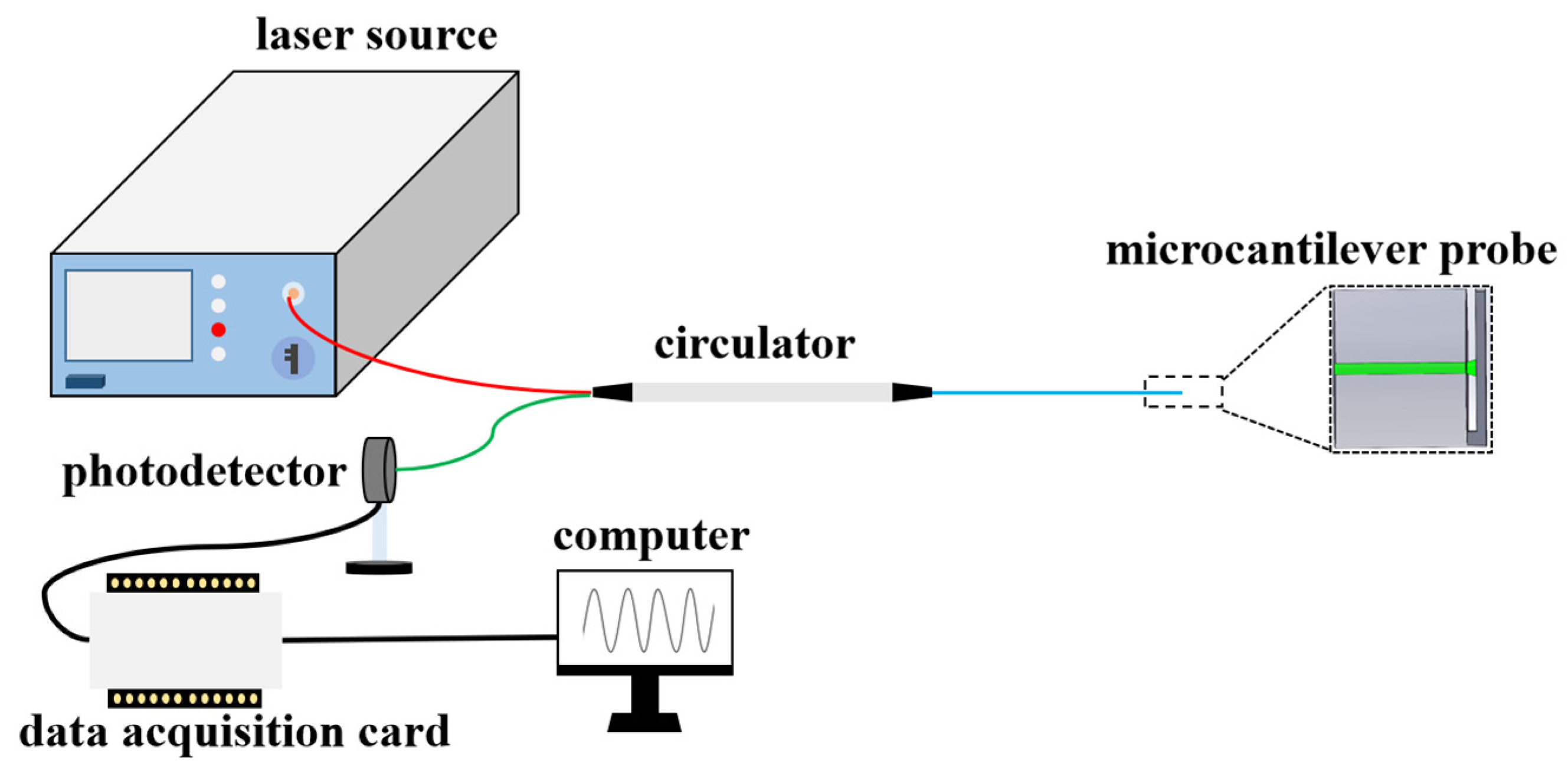
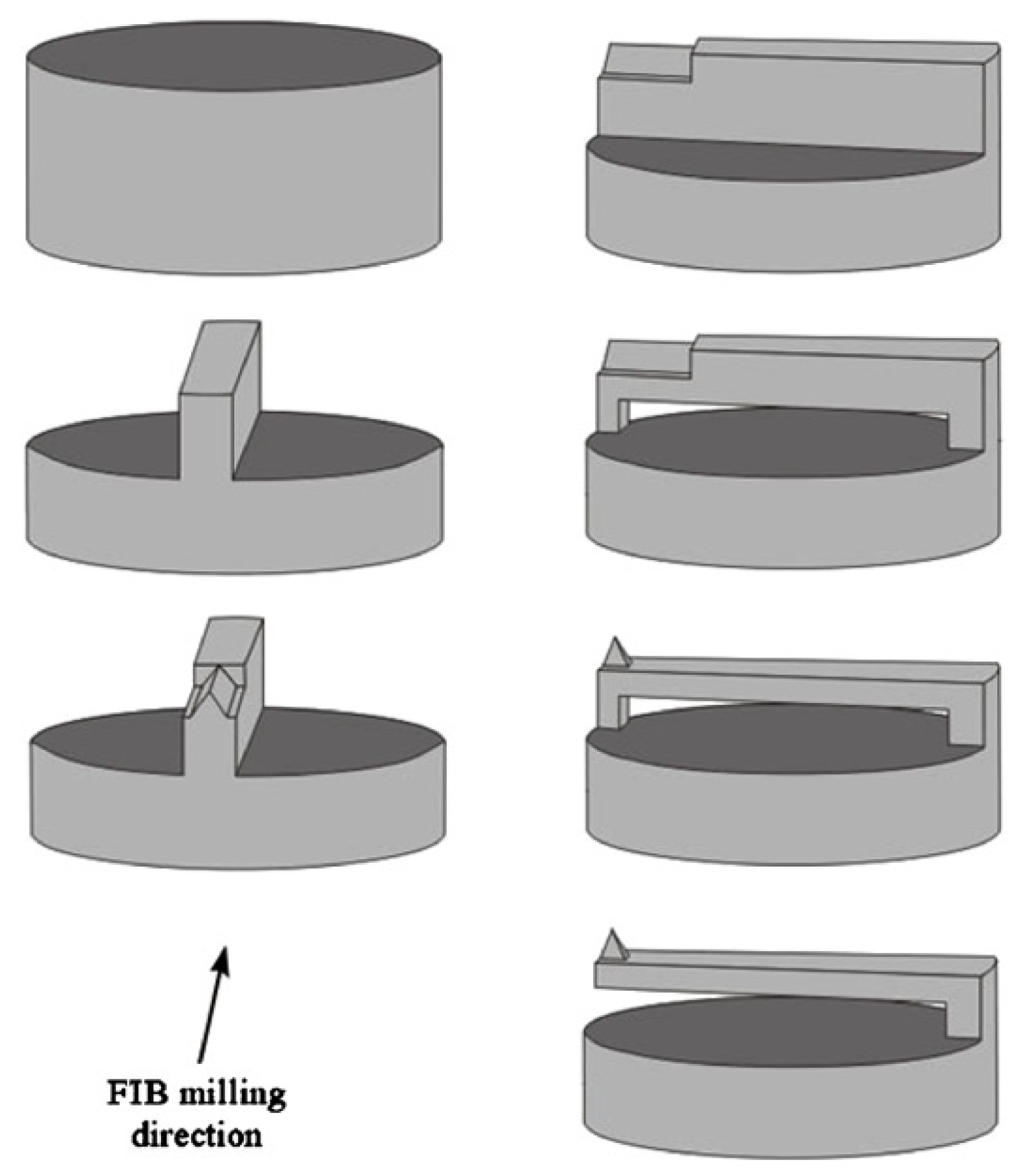

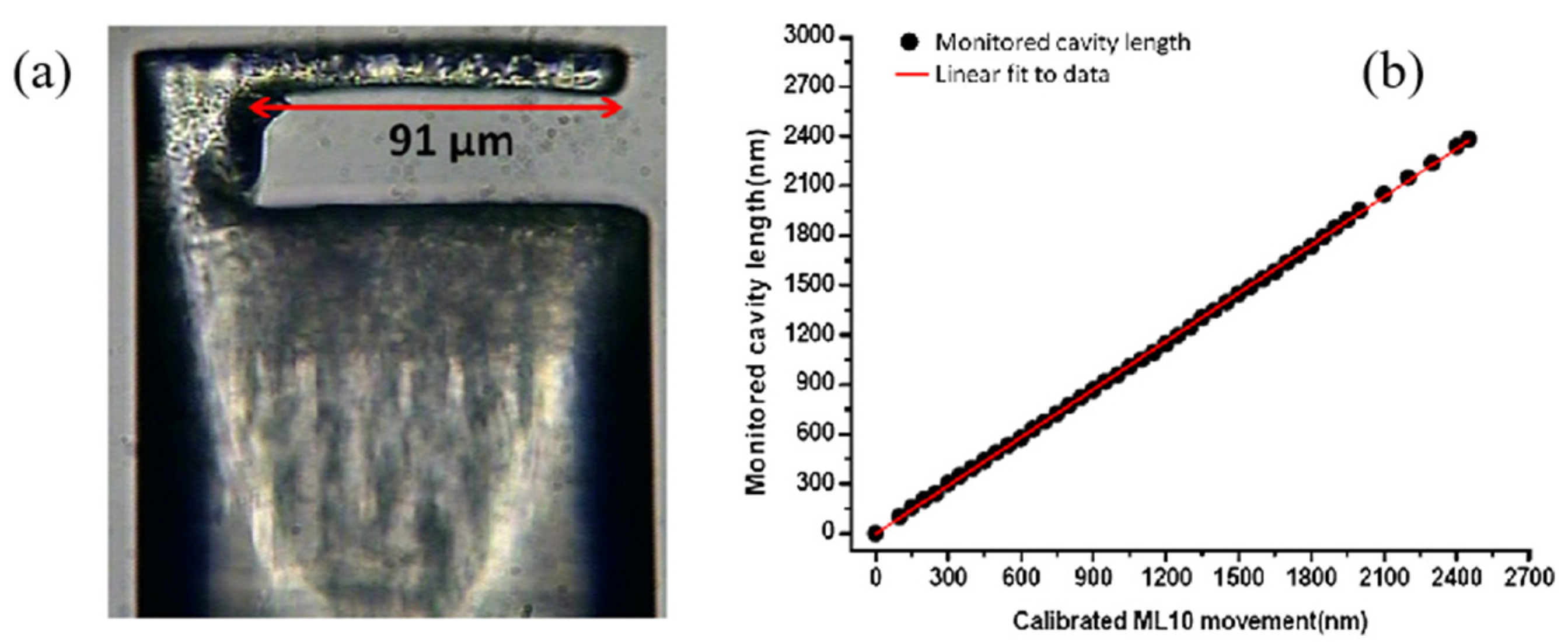
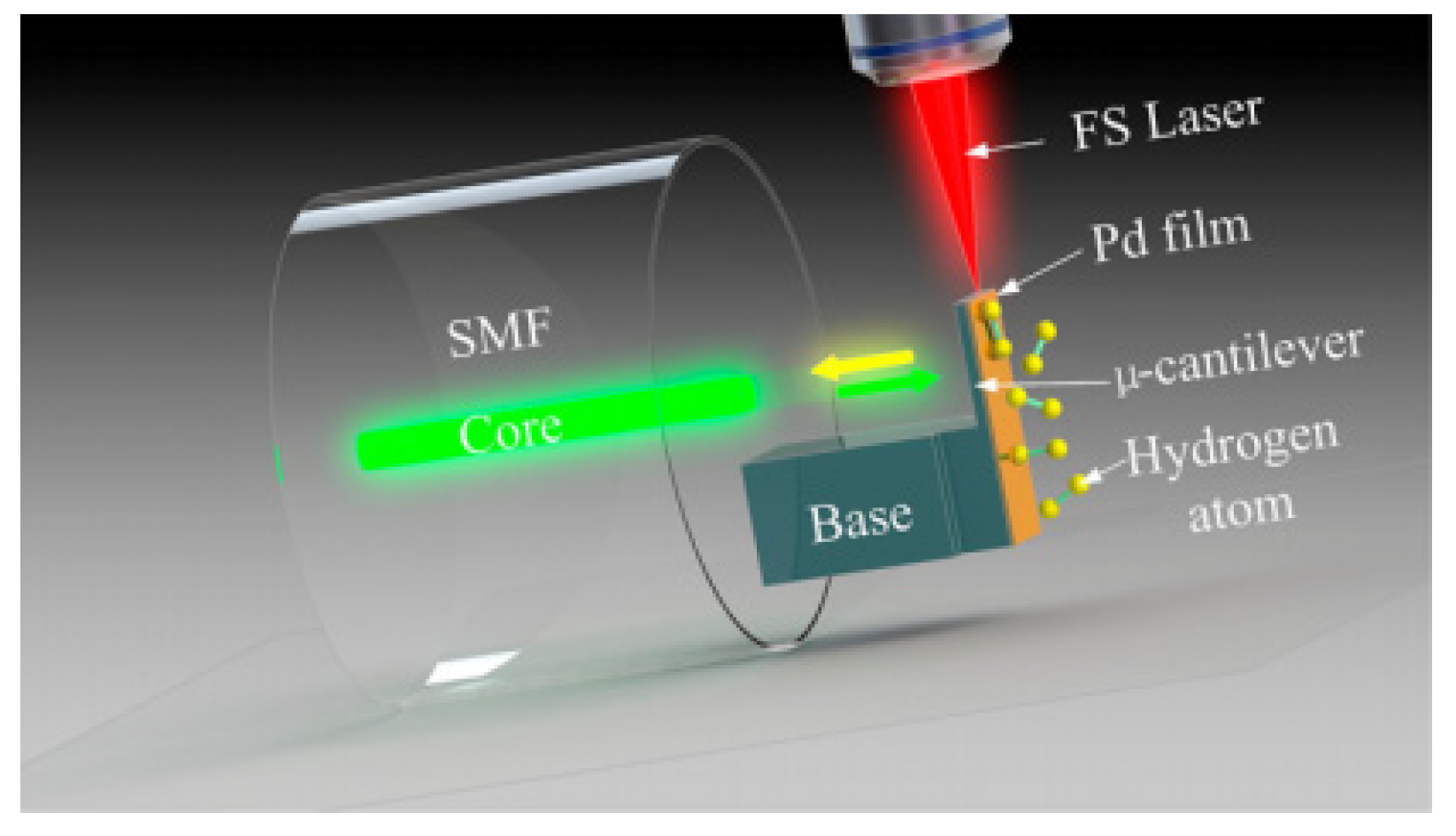

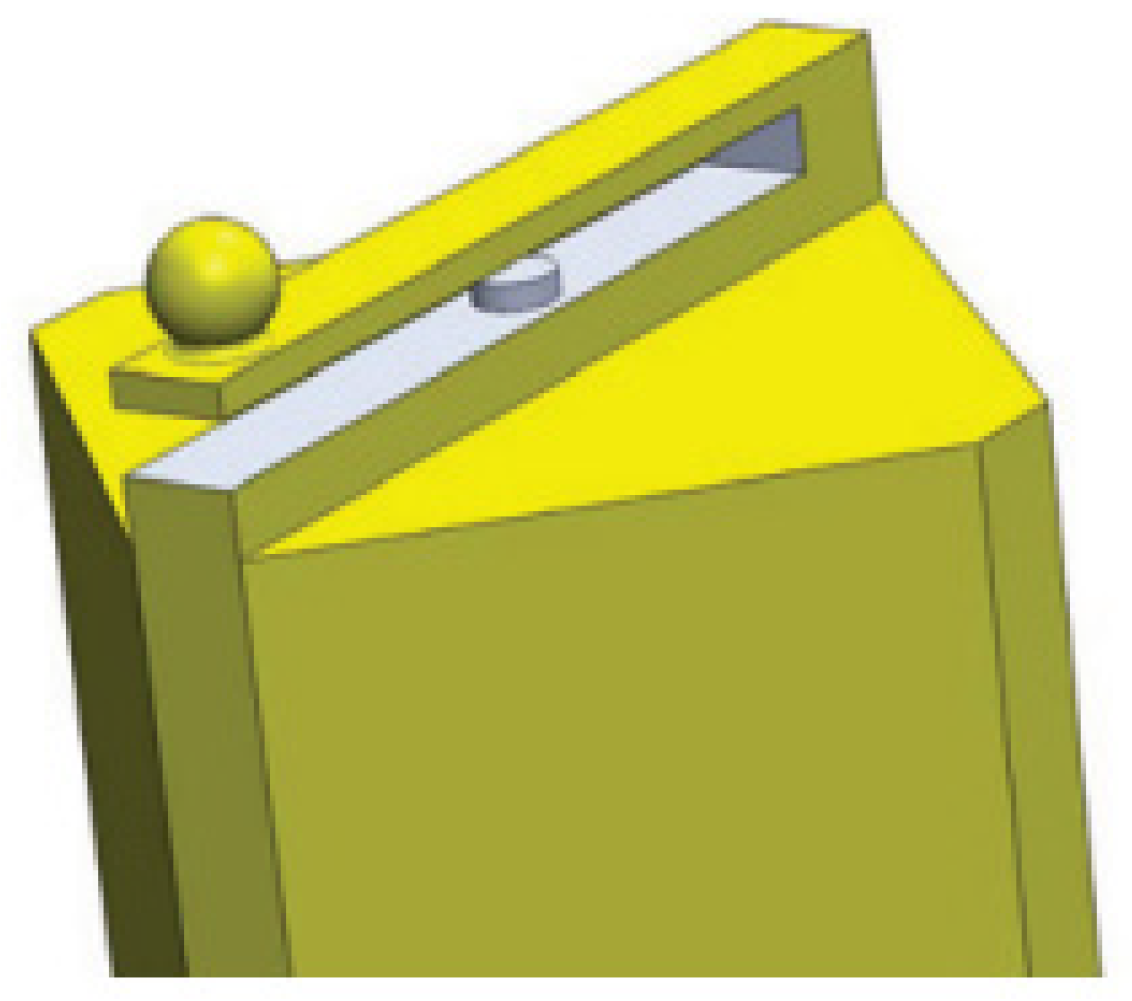

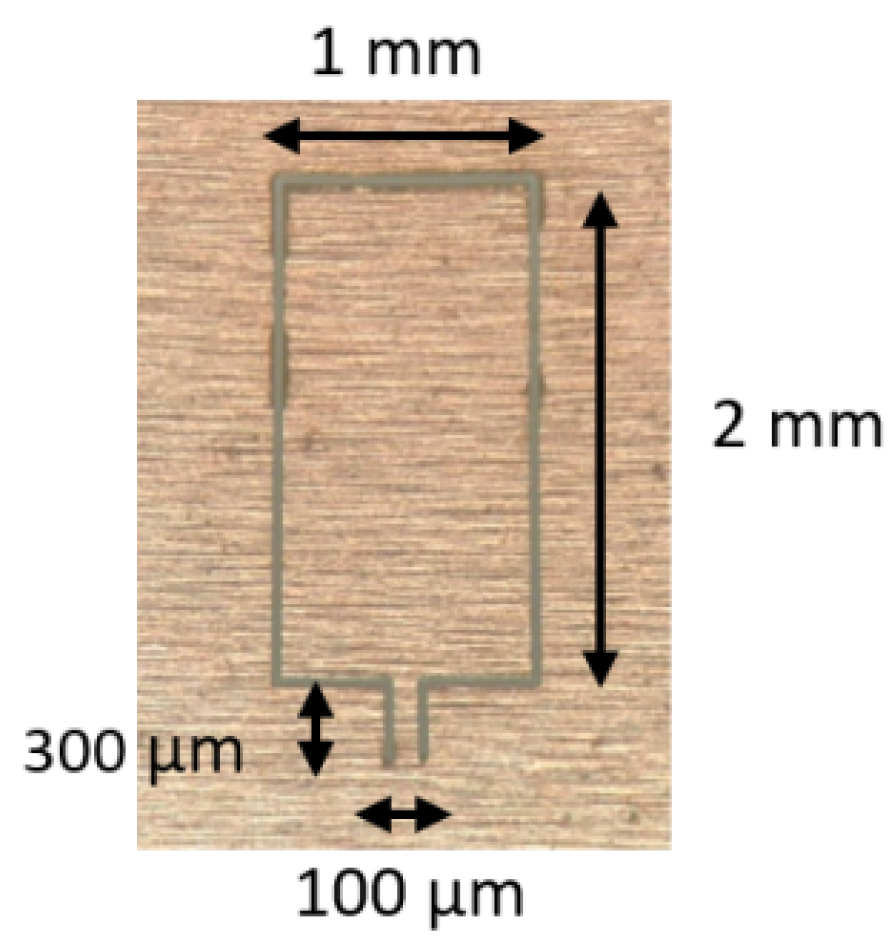
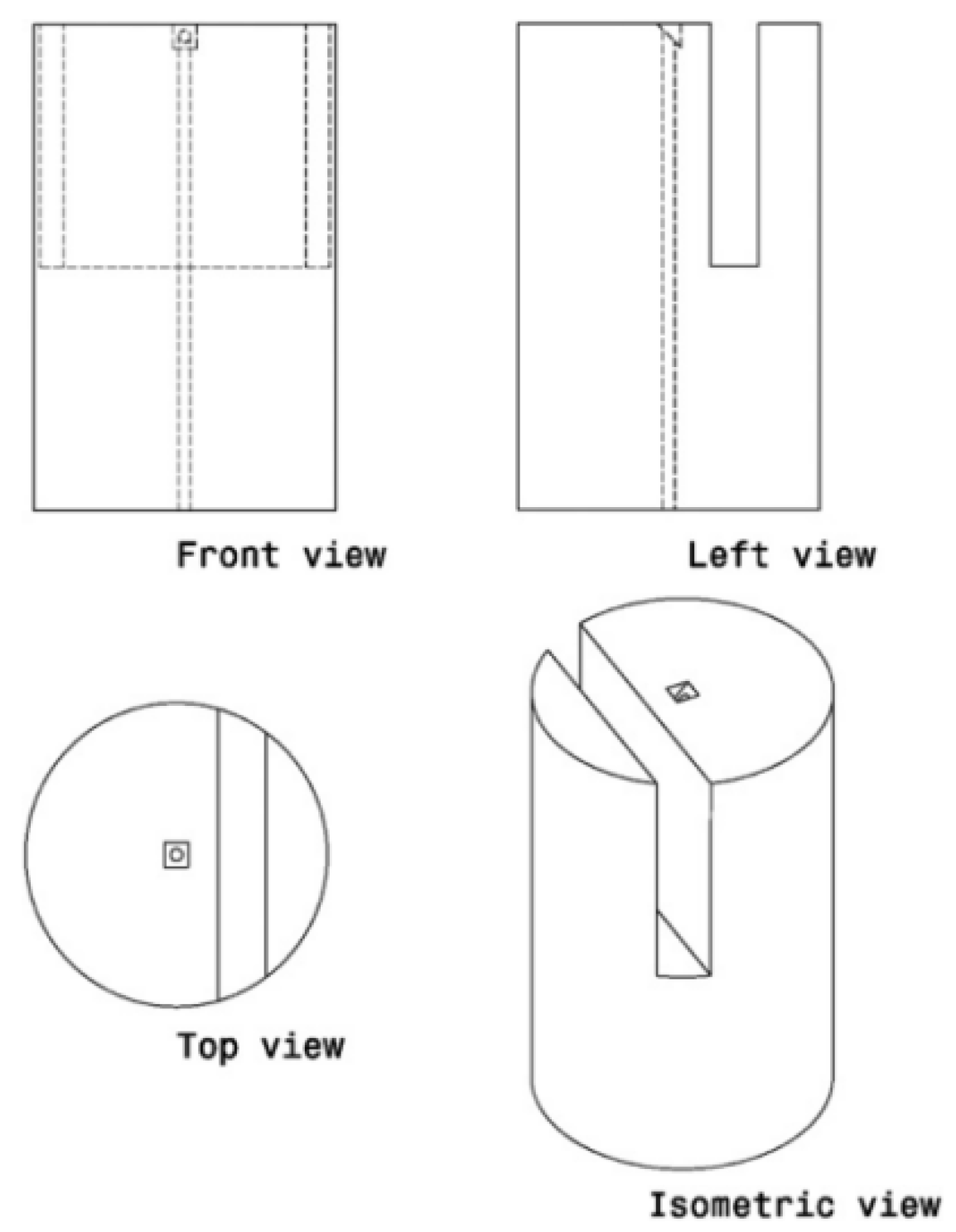

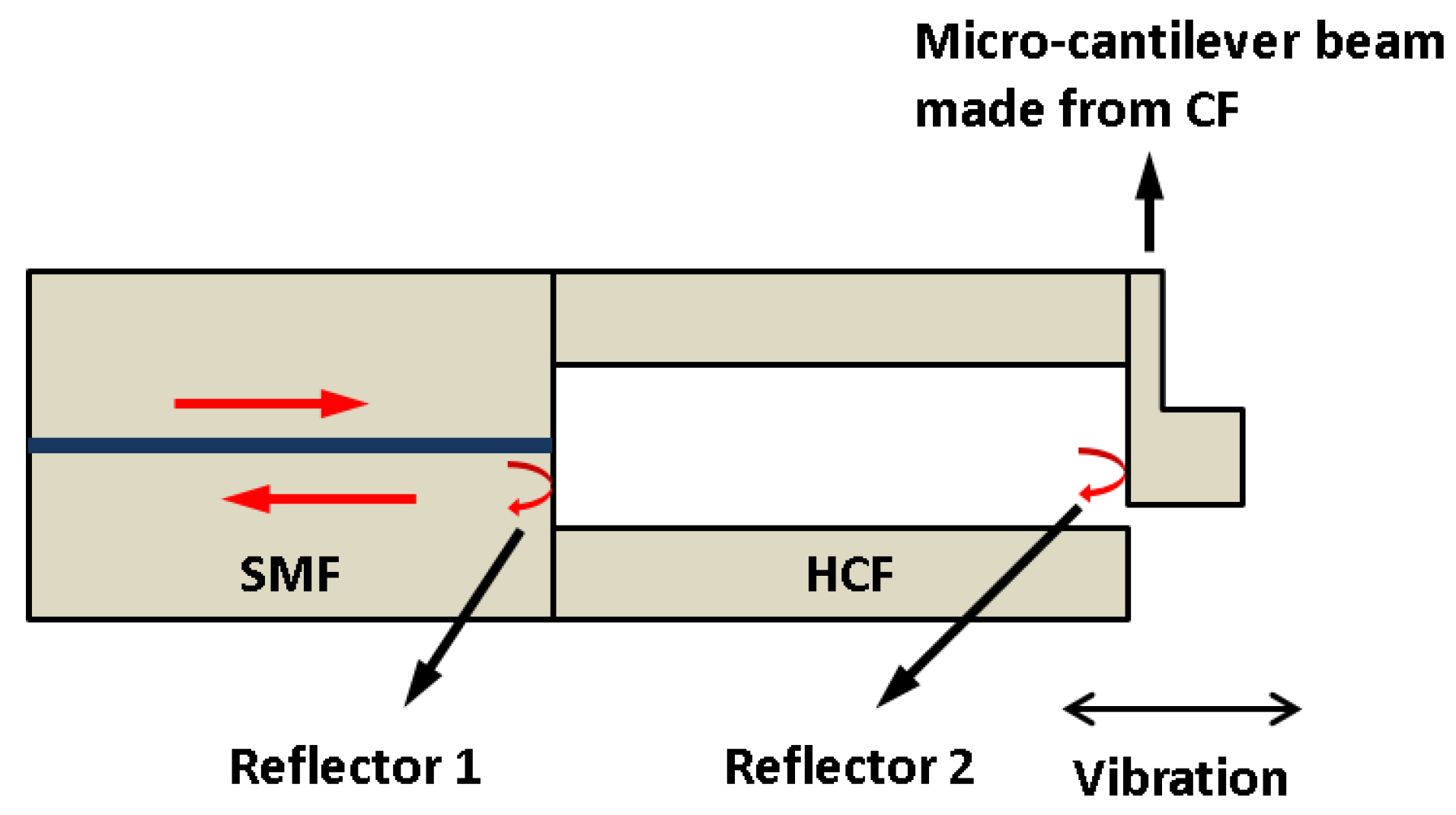
| Sensor Structure | Fabrication Method | Microcantilever Dimension (μm) | Sensing Application | Microcantilever Material | Ref. |
|---|---|---|---|---|---|
| Fiber-top | FIB milling | 112 × 14 × 3.7 | AFM, hydrogen | silica | [41,50] |
| chemical etching | 100 × 16 × 20 | displacement | silica | [54] | |
| ps-laser ablation | 110 × 20 × 10 | displacement | silica | [55] | |
| ps-laser + FIB | 110 × 18 × 2 | temperature, PH | silica | [43,56] | |
| photolithography | 11 × 7 × 0.35 | mass | gold | [57] | |
| TPP | 20 × 20 × 3 | hydrogen | polymer | [59] | |
| Glass ferrule-top | ps-laser ablation | 1600 × 200 × 30 | air flows velocity | Borosilicate glass | [66] |
| wire cut + ps-laser | 2800 × 220 × 35 | pressure, humidity | Borosilicate glass | [74] | |
| Ceramic ferrule-top | ns-laser ablation | 1400 × 300 × 25 | food pathogen detection | Polyimide | [77] |
| laser cutting | 1000 × 500 × 5 | microphone | Stainless steel | [78] | |
| MEMS | 530 × 200 × 3 | microphone | silica | [87] | |
| Fiber-side | ps-laser + FIB | 1000 × 35 × 6 | Accelerometer | silica | [91] |
| SMF-GT- microcantilever | fs-laser micromachining | 75 × 50 × 8 | hydrophone | silica | [93] |
Publisher’s Note: MDPI stays neutral with regard to jurisdictional claims in published maps and institutional affiliations. |
© 2022 by the authors. Licensee MDPI, Basel, Switzerland. This article is an open access article distributed under the terms and conditions of the Creative Commons Attribution (CC BY) license (https://creativecommons.org/licenses/by/4.0/).
Share and Cite
Chen, Y.; Zheng, Y.; Xiao, H.; Liang, D.; Zhang, Y.; Yu, Y.; Du, C.; Ruan, S. Optical Fiber Probe Microcantilever Sensor Based on Fabry–Perot Interferometer. Sensors 2022, 22, 5748. https://doi.org/10.3390/s22155748
Chen Y, Zheng Y, Xiao H, Liang D, Zhang Y, Yu Y, Du C, Ruan S. Optical Fiber Probe Microcantilever Sensor Based on Fabry–Perot Interferometer. Sensors. 2022; 22(15):5748. https://doi.org/10.3390/s22155748
Chicago/Turabian StyleChen, Yongzhang, Yiwen Zheng, Haibing Xiao, Dezhi Liang, Yufeng Zhang, Yongqin Yu, Chenlin Du, and Shuangchen Ruan. 2022. "Optical Fiber Probe Microcantilever Sensor Based on Fabry–Perot Interferometer" Sensors 22, no. 15: 5748. https://doi.org/10.3390/s22155748
APA StyleChen, Y., Zheng, Y., Xiao, H., Liang, D., Zhang, Y., Yu, Y., Du, C., & Ruan, S. (2022). Optical Fiber Probe Microcantilever Sensor Based on Fabry–Perot Interferometer. Sensors, 22(15), 5748. https://doi.org/10.3390/s22155748






